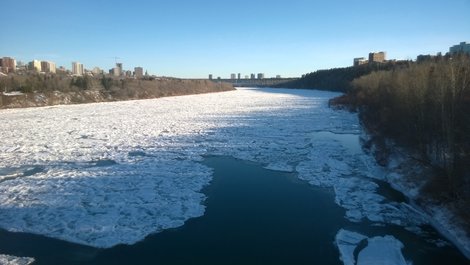Page path:
- ArcTrain
- Research stays abroad
- Research stay at the University of Alberta (GSV, TB, VM)
Research stay at the University of Alberta (GSV, TB, VM)
September - December, 2015 Edmonton, Canada

In early September 2015, after the ArcTrain summer school in Montréal, we stayed in Canada for a research stay at the University of Alberta in Edmonton.
Edmonton, located more than 3600 km North-West of Montréal, is the capital of Alberta and the University of Alberta (or U of A as we soon learned to call it) is one of the top universities of Canada with 39000 students from Canada and 150 other countries.
Edmonton, located more than 3600 km North-West of Montréal, is the capital of Alberta and the University of Alberta (or U of A as we soon learned to call it) is one of the top universities of Canada with 39000 students from Canada and 150 other countries.
During our time in Edmonton, we were part of the work groups lead by Paul G. Myers and Bruce R. Sutherland in the department of Earth and Atmospheric Sciences. Even though each of us were working on different topics, we all found the time at the U of A beneficial and valuable for our respective PhD projects. Tilia worked with the ARIANE tool, an offline application to track water masses in a numerical model forward and backward in time. Georg pursued a modeling study on wind driven internal gravity waves with his new collaboration partner Bruce R. Sutherland, an expert on stratified fluids and internal waves. Vasco extended his work on eddies in the North Atlantic from satellite and in-situ observations to two model simulations with different horizontal resolutions.
Apart from the possibility to use the outstanding research facilities in Edmonton, including the super computer cluster of WestGrid Canada, we extended our international network and built new connections and friendships that will hopefully last a lifetime. Furthermore, we were invited to attend and to present our research at the IGR (Institute for Geophysical Research) Symposium held on October 28, 2015 at the U of A. Tilia and Vasco were also invited to present their work at the VITALS (Ventilation, Interactions and Transports Across the Labrador Sea) workshop in Halifax from October 19 - 21, 2015.
But of course we were not only in Canada for science. Getting to know the life, the culture and the winter in Edmonton was a very exciting experience.
We want to thank ArcTrain for making this research stay possible and providing the financial support. We also want to thank Paul and Bruce for their enthusiasm, help with science questions and for welcoming us not only to their work groups, but also in personal moments like Paul’s Thanksgiving celebration.
Georg S. Völker, Tilia Breckenfelder, Vasco Müller
Apart from the possibility to use the outstanding research facilities in Edmonton, including the super computer cluster of WestGrid Canada, we extended our international network and built new connections and friendships that will hopefully last a lifetime. Furthermore, we were invited to attend and to present our research at the IGR (Institute for Geophysical Research) Symposium held on October 28, 2015 at the U of A. Tilia and Vasco were also invited to present their work at the VITALS (Ventilation, Interactions and Transports Across the Labrador Sea) workshop in Halifax from October 19 - 21, 2015.
But of course we were not only in Canada for science. Getting to know the life, the culture and the winter in Edmonton was a very exciting experience.
We want to thank ArcTrain for making this research stay possible and providing the financial support. We also want to thank Paul and Bruce for their enthusiasm, help with science questions and for welcoming us not only to their work groups, but also in personal moments like Paul’s Thanksgiving celebration.
Georg S. Völker, Tilia Breckenfelder, Vasco Müller


